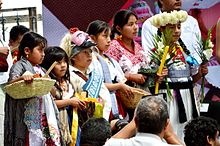Purépecha people

Purépecha children at the 2015 Muestra de Indumentaria Tradicional de Ceremonias y Danzas de Michoacán
|
|
| Total population | |
|---|---|
| (141,177 (2015 census)) | |
| Regions with significant populations | |
| Michoacán | |
| Languages | |
| Purépecha, Mexican Spanish | |
| Religion | |
| Purépecha religion |
The Purépecha or Tarascans (endonym P'urhépecha [pʰuˈɽepet͡ʃa]) are a group of indigenous people centered in the northwestern region of the Mexican state of Michoacán, principally in the area of the cities of Cherán and Pátzcuaro.
They are also known by the exonym Tarascan.
The Purépechas occupied most of Michoacán's territory, but they also occupied some of the lower valleys of both Guanajuato and Jalisco. Celaya, Acámbaro, and Yurirapúndaro were all in Tarascan territory. Today Purépecha people live mostly in the highlands of central Michoacan around lakes Pátzcuaro and Cuitzeo.
The Purépechas established the Tarascan state in the 14th century, which was one of the major pre-Columbian civilizations of Mesoamerica. Their capital city was Tzintzuntzan. Purépecha architecture is noted for step pyramids in the shape of the letter "T". Pre-Columbian Purépecha artisans made feather mosaics making extensive use of hummingbird feathers which were a highly regarded as luxury good throughout the region.
The Purépecha were never conquered by the Aztec Empire, despite several attempts by the Aztecs to do so, including a fierce war in 1479. This was probably due to the presence of metal ores in Purépecha lands and their knowledge in metalsmithing, which was far superior to that of the Aztecs; these skills have persisted in their descendants and are still widely regarded today, in particular their coppersmithing. Even though they were enemies with the Aztecs, the Aztecs still traded with them, mainly for metal tools and weapons.
...
Wikipedia
